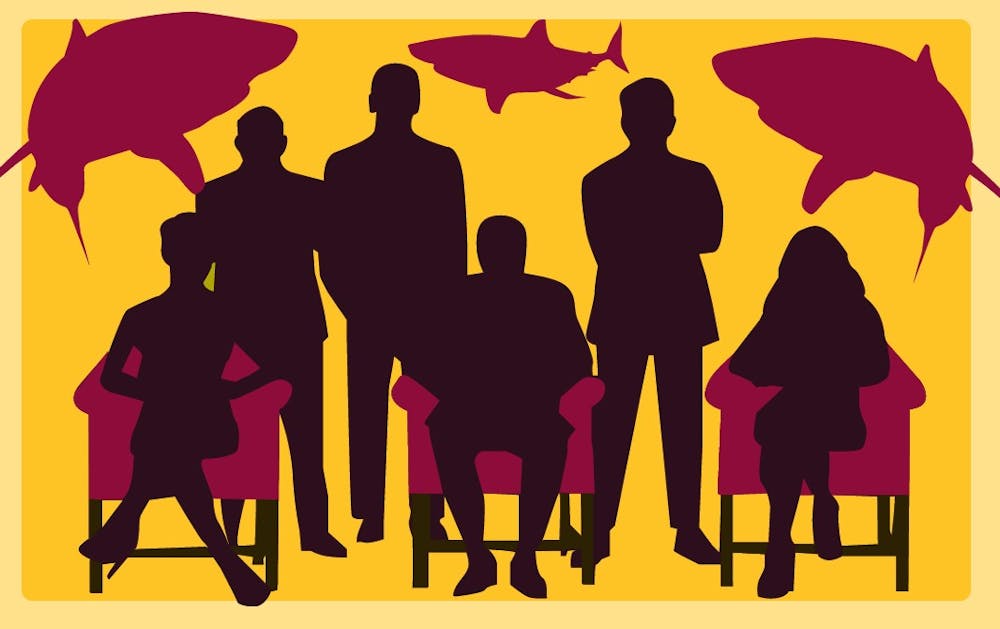Two alumni of ASU's Ira A. Fulton Schools of Engineering secured a deal with more than half the panel of the show “Shark Tank” for their startup company, Aira.
Eric Goodchild and Jake Slatnick presented a wireless charger that uses "FreePower" technology, which they created to charge multiple devices at once. The Aira charger works on devices with wireless charging capabilities including products from Apple, Google, HuaWei and Samsung.
The team brought Robert Herjavec, Lori Greiner and Kevin O’Leary together to invest $500,000 in the company for a 15% equity stake.
Goodchild said they worked incredibly hard both on their proposal and organization of the logistics of the presentation.
“You spend a lot of time prepping for something like that, and so I mean there’s a lot of buildup to the actual filming of the event and all that,” Goodchild said.
Goodchild said winning made it feel like the hard work developing the technology and strategically planning their business was paying off.
“(We thought that it was) going to be a huge letdown or it’s gonna be super awesome and you know, whatever it is, it is, so we just went in and did it, and more than anything I guess it was just a big weight off your shoulders,” Goodchild said.
Aira's technology, FreePower, allows the user to charge their device regardless of its placement on their charging pad, a unique advantage of Goodchild and Slatnick's product.
Aira’s FreePower technology makes the device more convenient and effective, and therefore more desirable for the user.
“Essentially, we’re wireless charging technology and what we’ve done that’s really unique is introduced freedom of position into the existing wireless charging ecosystem,” Slatnick said.
Slanick explained that a technology called "Qi" enabled them to make their product compatible with such a wide variety of devices. Slatnick said the Qi (pronounced “chi”) standard is, much like the HDMI cable, a standardized form of technology. It enables phones equipped with wireless charging to use the same chargers.
“The only reason why wireless charging is used is for convenience; it’s the only value proposition,” Slatnick said.
He said a wired connection will always be faster than any wireless device, but the other current models of wireless charging do not provide the improved convenience.
Slatnick said the existing coil technology is the same across most wireless charging devices regardless of the price. He said that other devices use inefficient designs that require perfect placement of the device onto the charger’s “hot spot.”
“They’re all doing it the exact same way, and, I hate to say this, but it’s almost like a scam,” Slatnick said.
Goodchild and Slatnick met while studying engineering at ASU, and both graduated in 2015. Slatnick was part of the Entrepreneurship + Innovation program from its beginning.
“The idea of that program is actually to bring entrepreneurship to the kind of hands-on engineering environment so that entrepreneurs and engineers can work together on solving different problems,” Slatnick said. “I guess the model was sort of validated in some sense with what we’re doing here.”
Tracy Lea, assistant director in the Entrepreneurship + Innovation program who leads the ASU Venture Devils program, said that these students' success shows how the learning environment at ASU can drive students to make a big impact in their professional lives.
“ASU really continues to drive that entrepreneurial mindset which results in amazing accomplishments and ideas that end up going to market,” Lea said. “It goes to show if you connect ideas and people, what can come out of that. It's very exciting to be at an entrepreneurial university at ASU.”
Goodchild said that they have enlisted other investors in conjunction with their deal on "Shark Tank" and their plan is to move forward with bringing their technology to market in a partnership with Nomad, the technology accessory company that will sell the devices.
Goodchild said the investments will help them continue what they’ve been working on for the last few years, hire more engineers and set up manufacturing to speed up the release of the product to the market.
“In the future, we hope that everybody kind of associates freedom of position and wireless charging with FreePower, similar to how you associate tissues with Kleenex,” Slatnick said.
Reach the reporter at gmlieber@asu.edu or follow @G_Mira_ on Twitter.
Like The State Press on Facebook and follow @statepress on Twitter.




